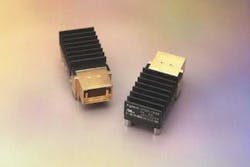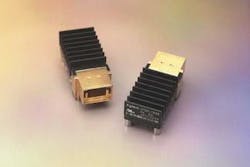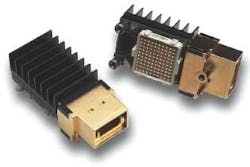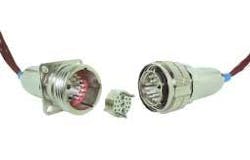Military systems designers know they need to upgrade their optical systems with new-generation connectors, so they are finding new ways to blend commercial pricing and reliability with military-style ruggedness in the optical data interconnects of the future.
Communications and computer systems designers in private industry are steadily boosting their investments in fiber optics so they can move large amounts of data quickly, reliably and securely. Military systems designers, meanwhile, are designing and upgrading in ways that employ these evolving technologies.
Yet cost-conscious officials in the Pentagon are moving to fiber optics much more slowly than are their commercial counterparts. This means military designers must maintain a large amount of relatively old equipment during their migration from copper to optics, and from old and expensive Mil-T-29504 fiber optic interconnects that have been used for the past 15 years.
Several companies have made substantial research investments not only in optical technologies, but also in finding a replacement for classic Mil-T-29504. "There has been a lot of movement in the last five or six years in the communications market as data speeds have increased. They clearly identified a crossover point where copper no longer was efficient to move bulk data at speeds greater than 10 gigabits per second (Gb/s)," says Jay Betker, director of business development and engineering at ITT Industries, Cannon in Santa Ana, Calif.
null
null
"From the work we did in telecom, where they were looking at all optical switchers and routers, the whole architecture had moved from copper to optical," Betker says. "By two years ago, everything had jumped to optic connections in communications, but there had been no movement in aerospace and defense. We could either take a commercial optical architecture and make it more robust and try to hold the cost, or take a mil-style product that was already robust and take out cost. That was the direction we went — injecting COTS technology out of the communications market."
The result was Cannon's environmentally sealed PHD 38999 optical interconnect series, which starts with the basic form and functional characteristics of the MIL-C-38999 Series III electrical connector — using Mil-T-29504 optical terminals — and supporting all standard shell clocking positions.
Aside from those compatibility points for legacy applications, however, the new interconnects use the PHD 1.25mm ceramic ferrule architecture. Cannon experts claim this combination of state-of-the-art optical architecture with a proven aerospace contact retention system has led to superior density, optical performance, cost, and durability that have exceeded all shock and vibration environment requirements for next-generation fighter aircraft.
"We took the cost of the components and the performance in the commercial communications market and shifted it over to the military market," Betker says. "If you look at a MILTECH 29504 interconnect, the specification requires a maximum insertion loss of 0.75dB. If you flip over to the commercial space, they are looking at sub-0.1dB. The ceramic companies and some of the epoxy systems used in commercial systems allowed these very-high-performance interconnects at low cost due to scale of production. By rolling the commercialized products over, you end up with high-end commercial performance and pricing with military ruggedness."
Military designers today are moving to what Betker calls "the cusp of what the commercial market realized about two years ago," which is that all backbone architectures are switching from copper to optics. This phenomenon, he says, is the driving force for Cannon and other optical element companies. Original fiber optic systems on the new F-22 jet fighter and Joint Strike Fighter (JSF), as well as upgrades to the Airborne Warning and Control system (AWACS) aircraft and F/A-18 fighter-bomber, are primary evidence that copper backbones are disappearing.
Another example that fiber proponents cite is the "Hairy Buffalo," an aging NP-3C aircraft that engineers at Lockheed Martin converted to a dedicated research test bed for networkcentric warfare and time-critical targeting. As part of that conversion, engineers ripped thousands of pounds of copper out of the aircraft and replaced it with optical fiber. While the "Hairy Buffalo" is strictly a technology test bed for the Navy's multi-mission aircraft (MMA), it is demonstrating future possibilities beyond the MMA. The aircraft test bed focuses on sensor, communications, and targeting systems, and not is representative of any operational platform or capability.
"The fiber optic technology developed for Hairy Buffalo is being commercialized into Airbus and Boeing for in-flight entertainment systems — very high-speed data infrastructures to every seat aboard a commercial airliner," Betker says. "So there is a give and take; the commercial industry driving costs down, the military building robust systems utilizing that."
Optical field support
A major weak spot in the military's conversion to fiber optics is the interconnect; engineers are having difficulty finding designs that will fit the long-term requirements of defense systems — regardless of fiber type in the future — combined with strong supportability in the field.
"If JSF winds up with maintainability problems with its fiber optics, then all future aircraft programs will look elsewhere, so programs like JSF are extremely important to the future of this technology," Betker says. The so-called "DDX" — the U.S. Navy's next-generation destroyer — is another crucial program involving fiber optics. The DDX forms what Betker calls "the foundation to validate the use of fiber optics as the mainline solution for the next 10 years."
The reliability and lifetime costs of new fiber optic systems are an equally important issue, he says. "Because the optical arena is still relatively new in the military space, a lot of people are uncomfortable in making the conversion unless they have no choice, such as JSF. But what they do for JSF today is what they will do for F-16 in the future," Betker explains. "It will become the defacto standard going forward. The cost of moving data optically is at parity with the copper world at 10 Gb/s, but when you get above that, there is no parity — you have to get into optical."
It is the military's need for systems that will survive severe environments for decades — physically and technologically — that industry is trying to address.
Tyco Electronics Fiber Optic Business unit in Harrisburg, Pa., is working to build on its heritage of Army field-deployed technology with miniaturization based on optical technology. A problem is the extremely "dirty" environment of the battlefield, where contaminants, shock, vibration, moisture, etc., can get into the optical coupling bushing and quickly degrade performance to an unacceptable level. One solution that Tyco offers is to protect the fiber core with a dedicated optical insert — a separable interface with a grouping of one to four lenses in a concentric shape — to create a robust interface that can be cleaned and inspected.
Dust and dirt
"The problem with optics has always been how to put two fibers together, align them, and reduce the effects of misalignment, contamination, and so forth, over a 20-year lifespan or more," notes Jim Young, Tyco's business development engineer. "Dust and dirt are big enemies of light transmission, which can take a system predicted to run 20 years and bring it to a full fault in a single cycle. In a military application, in particular, there just isn't time to take the due care and caution to wipe and clean every interface. That's just not real world for military applications."
Tyco's Expanded Beam fiber optic connector/cable system adopts a copper connector approach to fiber, providing an easily cleaned interface while also creating a much larger light path, so any contaminant that does get in blocks less light and so has a much lower overall effect, says Earle Olson, the company's rugged optics product manager.
"Mutlimode fiber is 62.5 microns, a single mode 9 microns. With Expanded Beam for multimode, the working area is expanded to 200 times its original size; in single mode, 2000 times," Olson explains. "When the light leaves the fiber, it launches across into the ball lens and is expanded. It goes through the lens, is received by the other lens, and is focused back down onto the other fiber."
Addressing the same signal degradation problem Cannon cites, Tyco officials claim insertion loss is no longer a problem with their Expanded Beam approach because there is no physical contact with the interface.
"The ball lens is much harder and will withstand much more than the raw glass of the fiber and is much more durable and stable with respect to light. It works the same for both single and multimode, which is a big advantage," Young says. "Single mode is required to extend transmission distances beyond a few hundred meters, but it has been difficult to build single-mode connectors that will withstand environmental damage. Expanded beam means you don't have to worry about the connector interface — single and multimode have the same life. So it has come along at just the right time to answer that need."
null
Tyco officials say their Expanded Beam fiber optic connector also meets ARINC 628, Part 6, performance requirements, which include:
- insertion and extraction forces that should not exceed 4.4 pounds, and should not increase more than 10 percent after accelerated maintenance aging;
- no evidence of mechanical or performance defects after 500 mating cycles; and
- the ability for multi-fiber cable connectors to withstand 88.1 pounds of tensile force for a minimum of 10 minutes.
The specification requires performance tests that subject the connectors to extreme temperatures, accelerated aging, and immersion in sand, dust, and salt spray.
Overall, experts say the conversion to fiber will improve field maintenance and support while reducing weight, especially for aircraft.
"In airborne platforms, we believe there will be an increased focus on all-composite structures," Betker says. "One of the issues of all-composite structures is anyplace you use copper transmission lines, you have to provide secondary and even tertiary shielding — and the weight of that shielding begins to become a major percentage of the weight of the raw structure. So we believe there will be a major move by airframe manufacturers to optical, which needs no shielding and doesn't carry that weight problem. In upgrade programs, you can remove heavy copper harnesses, which enhances the performance of the aircraft."
Density is another issue — or the number of optical interconnects at one point. "If you look at the past five to eight years, most systems were simplex or duplex — a primary optical line with a backup," Betker says. "In the F/A-18, there are several points that have nearly 30 optical interconnects in a single connector; on the JSF, they are looking at upwards of 100 optical fibers in a single interconnect. The size of the connector now is being driven by the optical pin, so there is a drive for smaller connectors."
As new system architectures call for increased fiber counts, the size of the terminals must decrease to meet the demand for higher density.
Nevertheless, the answer does not lie only in doubling or tripling the number of connectors, because "as you go to smaller diameter ceramics, you get greater performance with lower cost," Betker says. "Build that on top of an industry-standard component and you get a 10-to-1 cost reduction. The irony is, the telecom industry has quality standards that far exceed what the military market has, so the quality of the ceramic components is actually higher than the military usually buys."
Tyco's Young agrees that smaller military components are forcing designers to find high-density alternatives to traditional connectors — either more contacts or contacts capable of handling higher data rates.
"The actual electronics also are getting squeezed. Where fiber optic single-channel transceivers used to be 1.5 inch by 0.5, in that same size we can now put 72 transceivers. And where before they ran maybe 100Mb/s, now those transceivers can go up to 5Gb/s per channel," Young says. "There also are a lot more I/Os per box. The development cycles are now looking at how to put much higher fiber counts together and use optics to support the densities these new military devices will need."
Another part of the problem, he says, is experience; military and defense-industry designers understand copper interconnects inside and out, yet few optical connector experts understand military design and procurement. "They want to make the jump into optic systems quickly and use outside expertise on how to make that transition. They present us with the copper signal and we create a design that makes it appear at another box 2 kilometers away," Young says.
An example of collaboration in this arena is the combination of Tyco and Xanoptix Inc. of Merrimack, N.H., a producer of commercial high-speed optical connection products for next-generation electronic data links and optical communications.
"Xanoptix has a breakthrough technology that basically puts optic capabilities onto silicon that traditionally had always required wire bonding. That's how you get to very high speeds and densities in optic components, such as a transceiver," Young says. "We already are looking at next generation, where we would take a silicon crossbar switch and embedded optics that can directly connect transceivers and crossbar switches. You can take that process to just about any kind of silicon chip. So the next step is already here and will allow much faster processor and backplane speeds."
The transceiver is a central concern to military users — military grade transceivers cost around $3,000 each, compared to $300 for a standard commercial grade element. The primary difference is ruggedness; while a commercial single- or multi-mode LC connector is ideal for a stationary system in a benign environment, it is inadequate to operate in the high temperature, high shock, and high vibration common to military equipment.
That is true not only in aircraft, but also on the ground and at sea. Battlefield communications are shifting to optical because it is difficult to break into, and the double-layer of cladding enclosing the fiber core also can insulate it with an outer layer noise barrier that further protects the data. So while optical cable is sensitive to tight bends and there are some mechanical attributes to consider, it is not subject to either noise injection or radiated emissions.
Xanoptix officials say their XTM Series of optical transceivers use hybrid integrated circuit technology that redefines optical communications by enabling extremely small form factors and very low costs per gigabit of bandwidth. Company experts say they achieve this by combining hybrid circuits with massively parallel optical transmitters and receivers, cutting-edge IC design (including on-chip laser drivers and receiver amplifiers), and newly developed high-density MT form factor ferrules enabling as many as 72 fibers per connector with as much as 245 Gb/s aggregate bandwidth.
Also enhancing the capability of the 72-channel transceiver is the vertical cavity surface emitting laser (VCSEL), a specialized laser diode that industry researchers say promises to revolutionize fiber optic communications by improving efficiency and increasing data speed.
"VCSEL technology costs about the same as an LED [light-emitting diode], but can be switched at much higher speed," Young says. "But you always need a backup solution, because they aren't perfect; you don't want one VCSEL to fail in a 72-channel transceiver. So you build four VCSELs per channel, which provides much more redundancy. But when you realize how much stuff is jammed in there, you are getting into much, much higher reliabilities, as well. You can embed that kind of optic structure right into standard silicon chips for military applications."
Another adaptation of commercially developed fiber optic communications technology for military communications applications from Lucent Technologies Integrated Network Solutions of Holmdel, N.J., is called LambdaXtreme.
"It is a third-generation dense wavelength multiplex system that provides very high capacity — 128 wavelengths at 10Gb/s per single fiber or 60 wavelengths at 40Gb/s per single fiber," explains Dave Einstein, technology manager for Lucent's optical networking group. "It also has significantly long reach, sending a signal without electrical generation — say 4,000 kilometers without regeneration for all 128 channels at 10Gb/s; for 40Gb/s, that's about 1,000 kilometers. That's about a factor of three longer than other deployed second generation systems. Many of the second gens only go about 600 kilometers without regeneration for 128 channel/10Gb/s, although there are some that can go 1,500 kilometers.
"LambdaX also can be upgraded much less expensively," Einstein says. "For example, you don't need regenerators in as many places. There also is automated wavelength provisioning, self-monitoring, and self-adjusting amplifiers. We support a single band of transmission, an extended L-band, and automatic system topology; the 10Gb/s transponders have tunable lasers. Instead of having 128 separate lasers, you have lasers that can tune over several different wavelengths, which reduces inventory requirements. We also support the entire 128 channels in three bays of equipment and low power consumption per gigabit."
While Lucent is fielding third-generation systems, experts from Agilent Fiber Optic Products Division in San Jose, Calif., are looking to the next level.
"The specific applications we see today are really the next generation — 4th generation — of scalable terabit routers in the telco and datacom domain," notes David Eastley, Agilent's parallel optics product manager. "If you think about the current capacity of generations 1, 2, and 3, they have scaled up in capacity within a single box from 10 gigabits to 80 gigabits to 160 gigabits per second and have reached a finite density in a given box. So there is a requirement to decant switched fabric and line cards into multiple chasses. Therefore, the interconnect between chasses can no longer be performed with an electrical backplane but is superceded by a parallel optical backplane."
Today's applications call for large, fat, cheap transmission pipes within systems or subsystems and the interconnect technology for those is moving closer to the microprocessor, sometimes called fiber-to-the-processor, he says. For high-speed supercomputers, high-speed interconnects within clusters of next-generation products also are in demand.
Agilent's approach to taking optical networking to the next level — such as scalable terabit switch-router backplane interconnections — incorporates parallel optics solutions from the company's METRAK family of optical components. Company experts claim those solutions also significantly reduce interconnect cabling and board space required for the next generation of terabit optical networking equipment. According to company literature, Agilent's parallel optics technology yields 90 percent savings in board edge space for the same bandwidth when compared to today's Small Form Factor Gigabit Ethernet transceivers.
"From an architecture perspective, there is a solution cost borne from both the parallel optic interconnect as well as the fiber cost, so if you simply extend the number of fibers, it actually increases the overall solution cost," Eastley says. "So the technology-looking-forward people are willing to stay with the 12-channel technology and increase the data rate down each fiber. The obvious way to do that is to crank up the data rates, but the real debate is going from 2.5 gigabits with today's technology and top off at 5 gigabits or align with other technologies to reach 10Gb/s, essentially quadrupaling the aggregate from 30Gb/s to 120Gb/s.
"In terms of increasing the data rate, there is a DARPA funded activity at the research level looking at putting multiple wavelengths down each fiber, as well, such as a course wavelength multiplexing technology. A simple architecture there would be to increase the data rate from 2.5GB/s to 10Gb/s and then send four colors of signals down each. If you multiply that by 12 or possibly 24, you end up with 300-to-600 Gb/s interconnect technology. That is a lab-based activity today. Increasing the data rate to 4x from 2.5 has been demonstrated, but it is not yet fieldable. The typical deployment timeframe is probably around 2005-06."
A key design consideration today, based on a quantum leap from a single transmit receive pad to four, is how to minimize any crosstalk penalties, he adds, and avoiding the path industry employed with gigabit ethernet, which stumbled into an electromagnetic interference (EMI) issue due to the interconnect speeds.
Eastley agrees with Tyco on the use of VCSELs to resolve some of those problems, but voices concern over the status of advanced applictions.
"We're using traditional 850 nanometer VCSEL technology, which has been around six or seven years and has been mass deployed into gigabit ethernet and Fibre Channels," he says. "With respect to increasing the data rate, 10 gigabits VCSELs are really unproved today. Currently you may use 5 or 6 milliamps to drive a VCSEL and you may need to double that to drive an equivalent VCSEL at four times the data rate. The hurdle is how to avoid delivering a solution with a short lifetime of only two or three years because of a tradeoff in longterm reliability and driving the device harder. So there is a lot of work to do to prove out longterm reliability of 10-gigabit VCSEL technology.
"There is an alternative — to migrate from a VCSEL source technology at 850 nanometers to essentially 980 nanometers," Eastley says. "That requires a different material system, with the aluminum content omitted, that has the promise of high reliability."
For high reliability, high speed, high volume, low cost, and ease of transition, the military is looking to the commercial suppliers to help develop the technologies to bring all those to fruition in an optical networking capability that also can be ruggedized to meet military environmental requirements. It is ruggedization as an overall requirement that is becoming increasingly important.
"The services will tell you it isn't a question of if but when fiber optics will be prevalent," says Cannon's Betker, who calls the conversion to fiber optics "future-proofing" critical systems. "All the systems now being built have fiber optics. In five years, we will see production of the systems being designed today, with multichannel fiber optics in every major platform. Look at JSF, which carries an all-optical backbone to the entire aircraft and synthesizes all data onto that backbone. And that's what you will see in five years.
"Ten years from now is a little murkier because it is highly dependent on the success of the next five years. If industry is successful in making repairable, maintainable, highly reliable and cost-efficient systems, there is no limit to fiber optics in future platforms."






